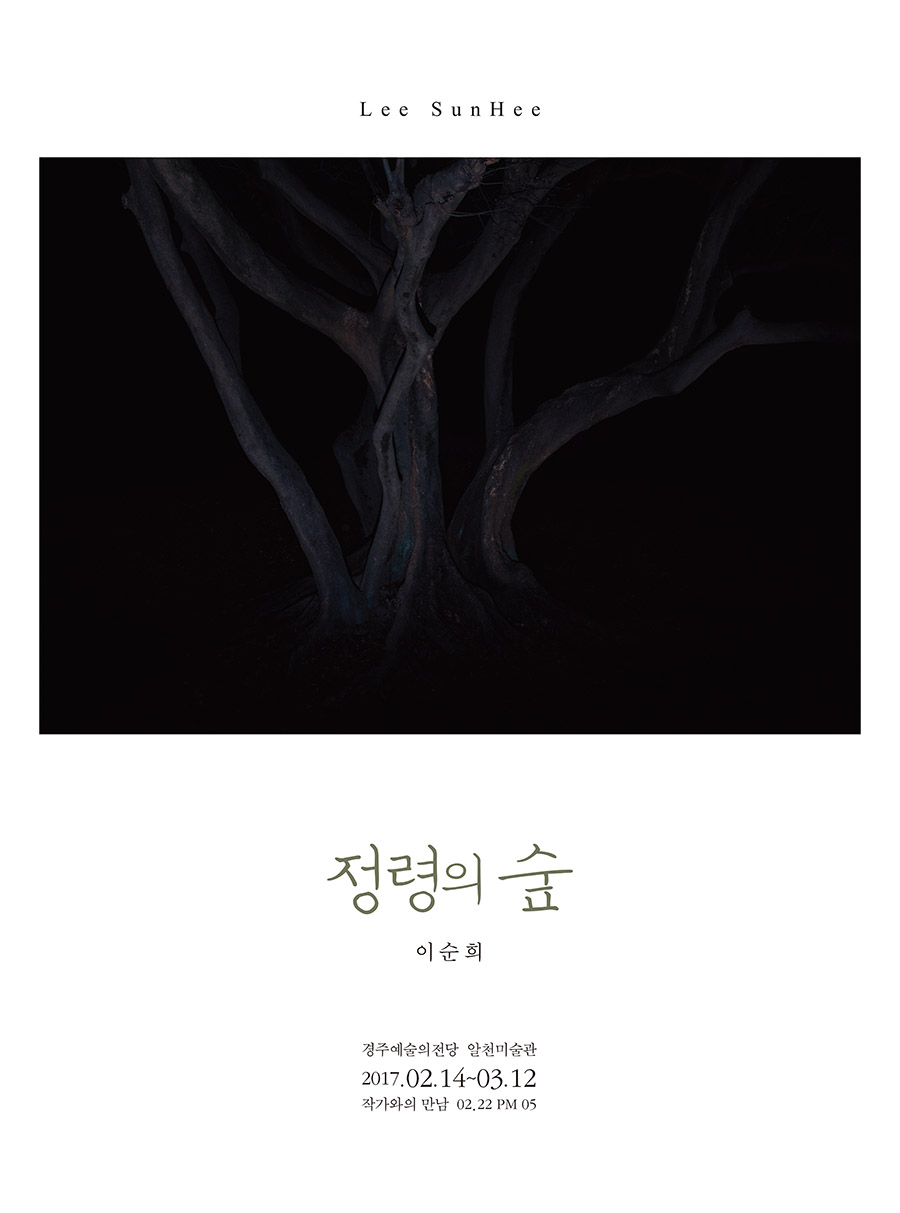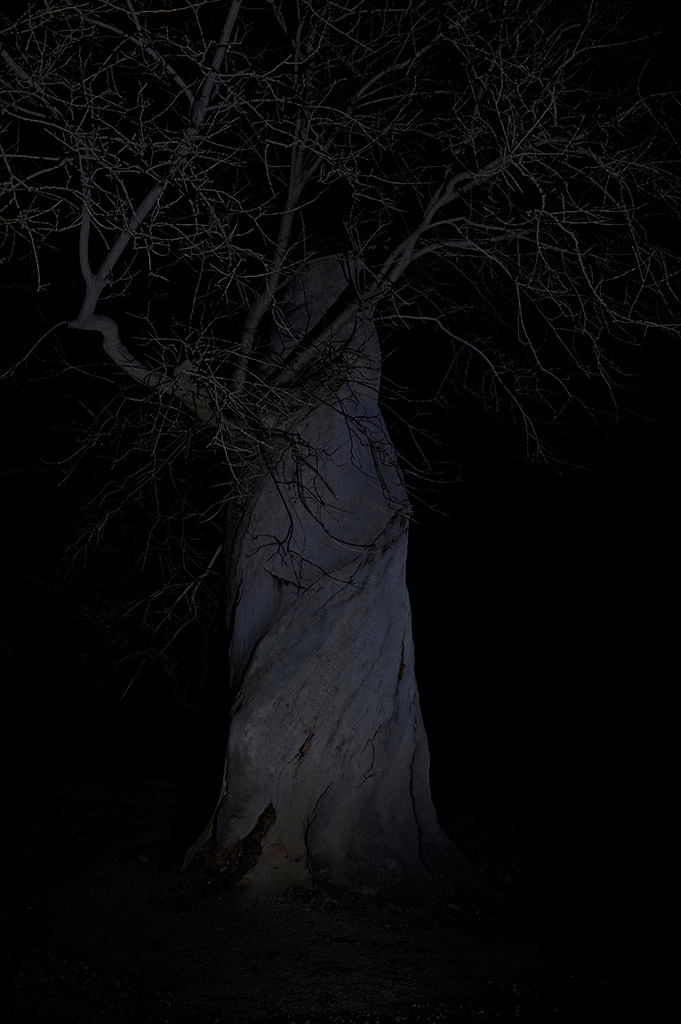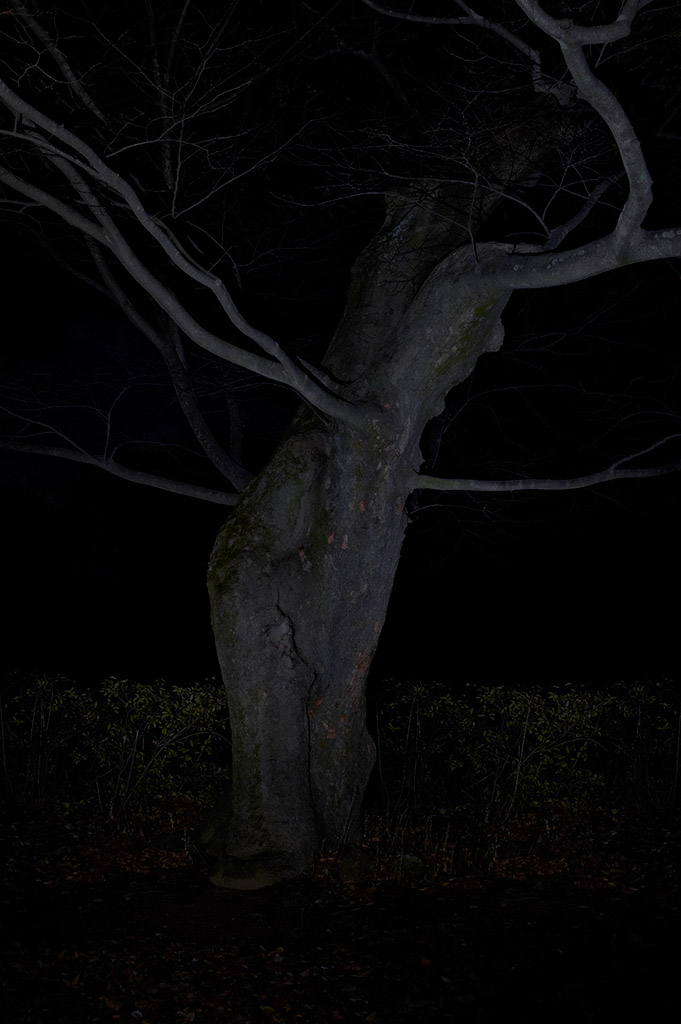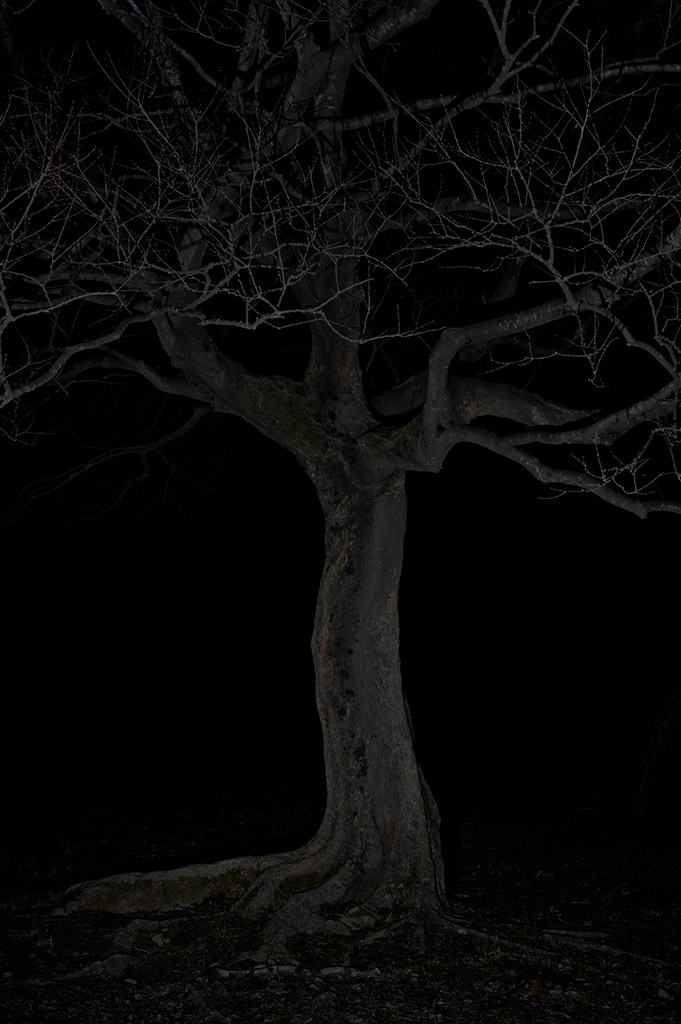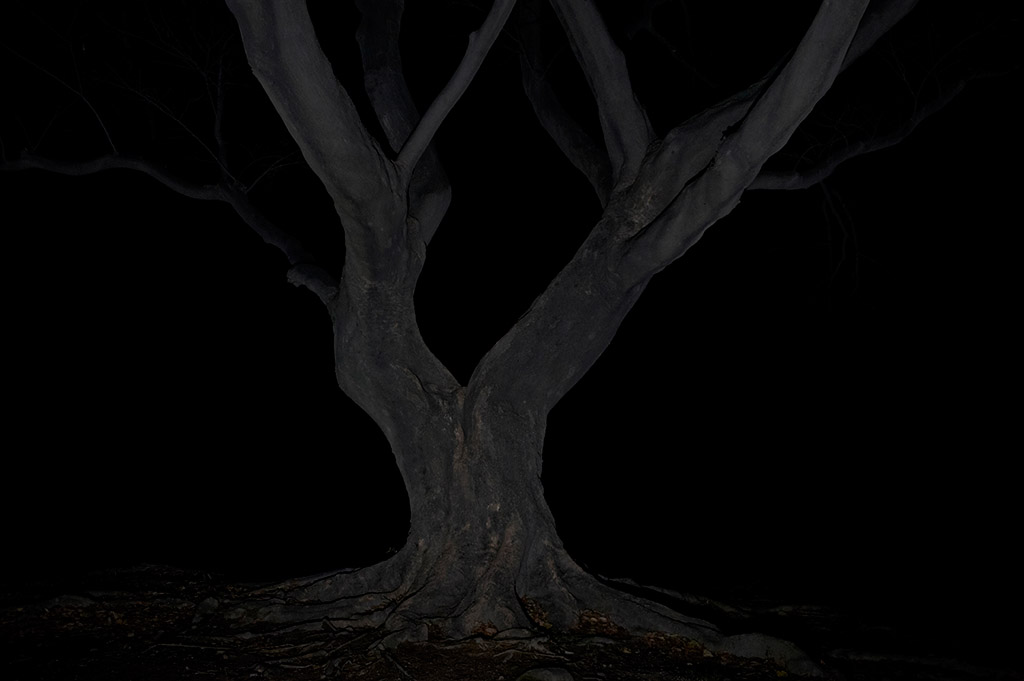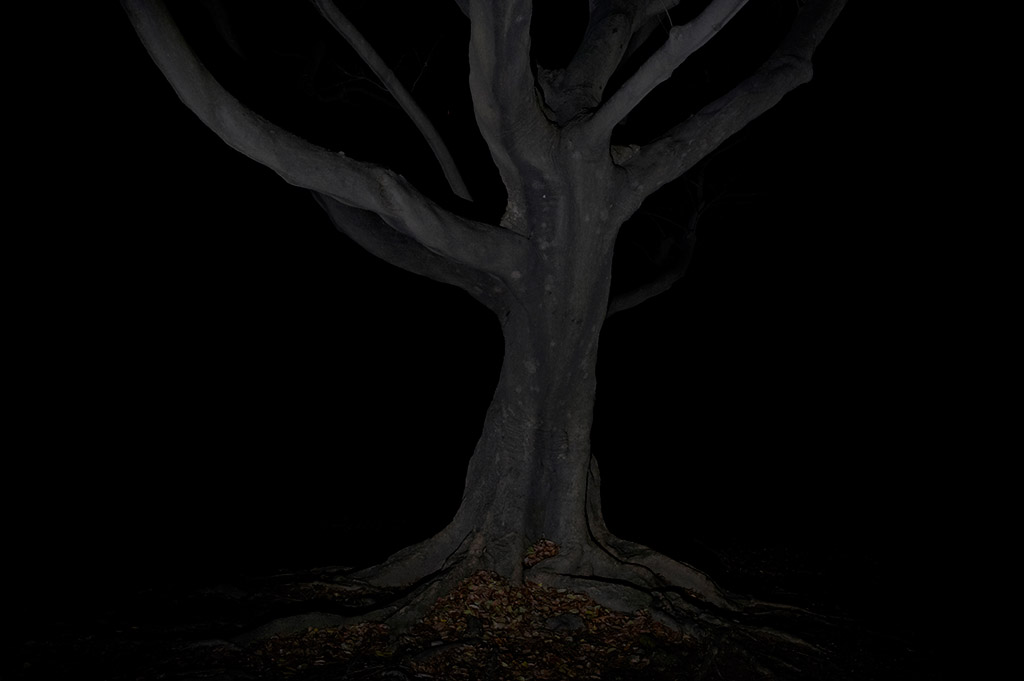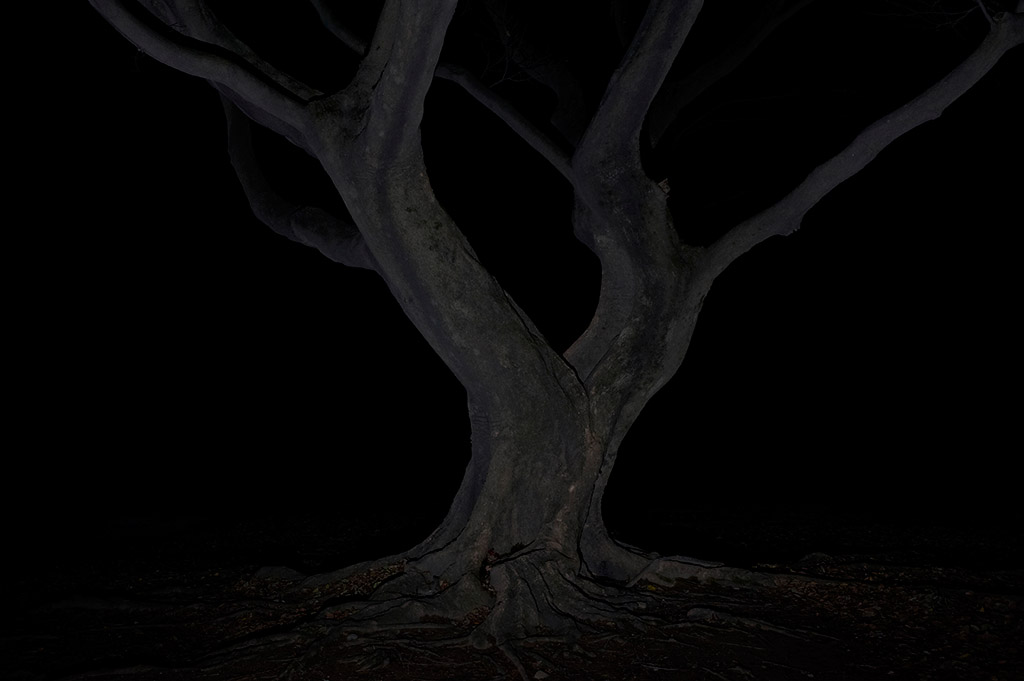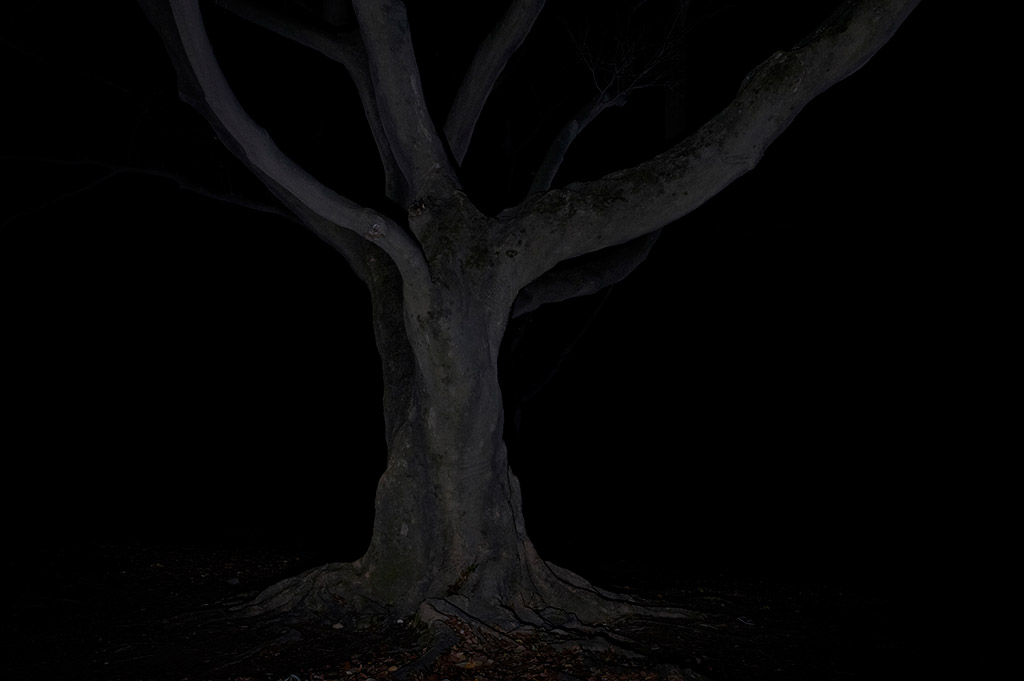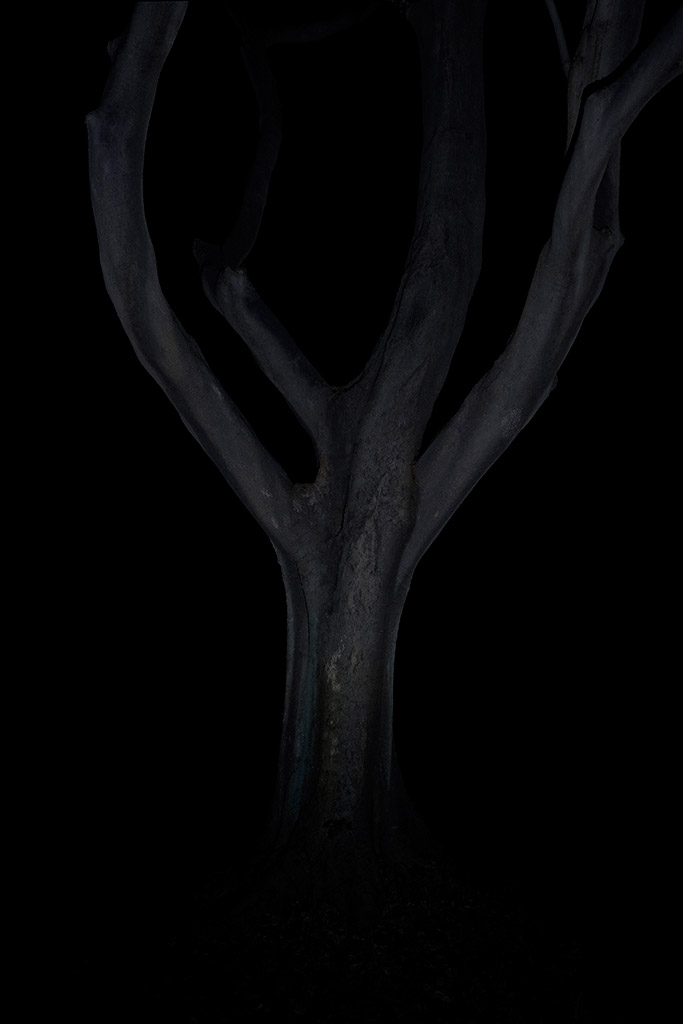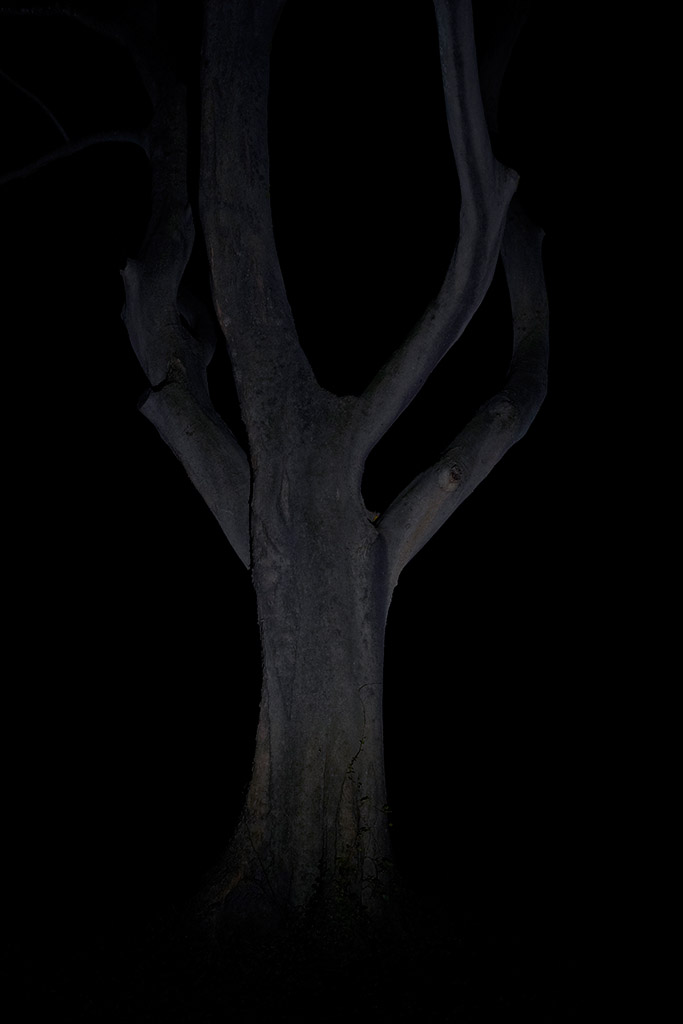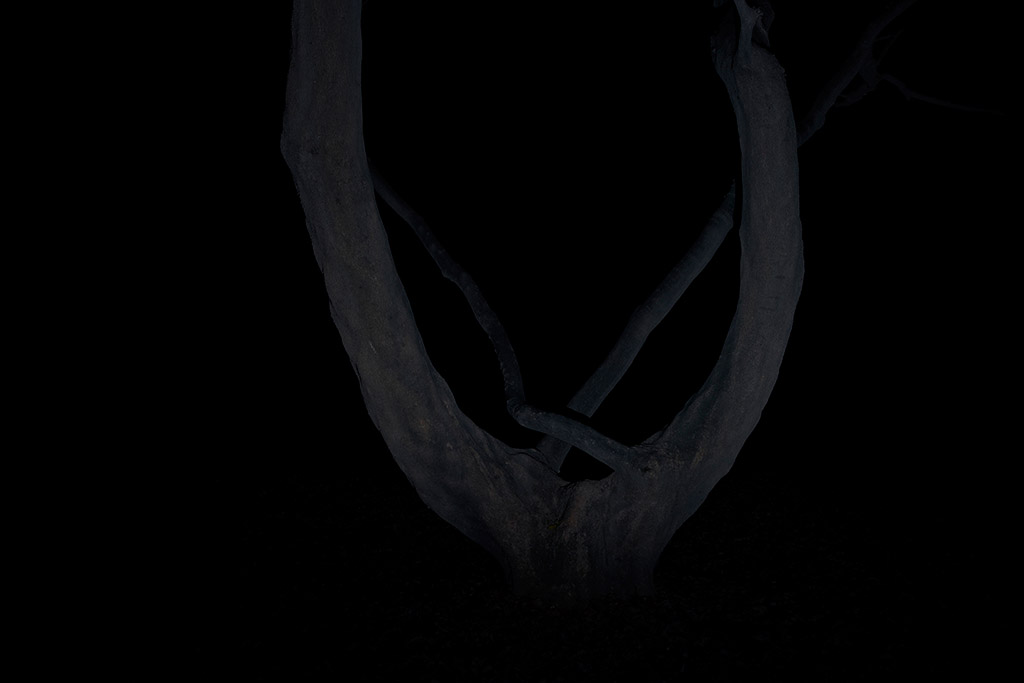‘정령의 숲’은 본인이 살고 있는 역사도시 ‘경주’를 촬영한 사진이다.
신라 천년의 시간과 김알지의 탄생 신화를 간직한 역사적 공간 계림의 나무는 경주의 많은 문화유적지들과 신라의 땅을 지키고 있다.
계림의 나무들은 마치 사람과 닮은 듯 한 모습에서 나무에도 영혼이 있는 것처럼 느껴졌다. 무리지어 있지만, 홀로 자라는 나무들은 나름의 정령(만물에 깃들어 있는 신령한 기운)을 갖고 있었다. 이 나무들은 시간의 변화를 느끼며 자신의 자리를 굳건히 지키기 위해 팔을 뻗어 하늘을 이고 지하로 뿌리를 내려 살아 숨 쉬고 있었다.
본인은 이러한 계림의 나무들에서 신라 고유의 에너지와 분위기를 느꼈다. 그저 평범한 햇살 아래에서도 나무들은 거대한 뿌리를 드러내며, 조용히 자신의 존재를 알리고 있었다. 자신의 존재를 알리는 이들과 조용히 마주서면 세상엔 이들과 나만이 존재한다. 이들의 독특하고 신비한 분위기를 표현하고 싶어 인적이 없는 이른 새벽이나 해 질녘을 선택하고 인공조명을 사용하여 주변배경을 어둡게 하고, 나무의 형태가 잘 드러나는 계절에 촬영하였다.
동양에서는 영혼이 인간에게만 있는 것이 아니라 존재하는 모든 사물에도 있어서 사람들처럼 살아간다고 믿었다. 이러한 동양의 우주관을 바탕으로 계림의 오래된 나무가 지니고 있는 신비로움과 조형성을 보이지 않는 기의 움직임인 ‘영’이라는 형상을 통해 표현하고자 했다.
무릇 사물이란 보이지 않는 기에 의해서 끊임없이 생성, 변화, 소멸하는 순환의 과정을 거치게 된다. 형용할 수 있는 것은 모두 존재하며, 존재하는 모든 것은 형상을 지닌 사물로서 나타난다. 사물의 형체와 외견을 통해 나타나는 분위기나 신령스러움은 보일 듯 보이지 않고 들릴 듯 들리지 않는다. 움직이는 기의 형상인 ‘영’은 구체적인 사물도 아니며 형태도 없지만, 존재의 본질이며 정신이다.
본인은 보이지 않는 기의 흐름에 따라 그 외형을 달리하는 사물들이 만들어 내는 풍경을 인식하고 표현하는 작업을 하고 있다.
정령의 숲 (Forest of spirits)
이순희
‘정령의 숲’은 본인이 살고 있는 역사도시 ‘경주’를 촬영한 사진이다.
신라 천년의 시간과 김알지의 탄생 신화를 간직한 역사적 공간 계림의 나무는 경주의 많은 문화유적지들과 신라의 땅을 지키고 있다.
계림의 나무들은 마치 사람과 닮은 듯 한 모습에서 나무에도 영혼이 있는 것처럼 느껴졌다. 무리지어 있지만, 홀로 자라는 나무들은 나름의 정령(만물에 깃들어 있는 신령한 기운)을 갖고 있었다. 이 나무들은 시간의 변화를 느끼며 자신의 자리를 굳건히 지키기 위해 팔을 뻗어 하늘을 이고 지하로 뿌리를 내려 살아 숨 쉬고 있었다.
본인은 이러한 계림의 나무들에서 신라 고유의 에너지와 분위기를 느꼈다. 그저 평범한 햇살 아래에서도 나무들은 거대한 뿌리를 드러내며, 조용히 자신의 존재를 알리고 있었다. 자신의 존재를 알리는 이들과 조용히 마주서면 세상엔 이들과 나만이 존재한다. 이들의 독특하고 신비한 분위기를 표현하고 싶어 인적이 없는 이른 새벽이나 해 질녘을 선택하고 인공조명을 사용하여 주변배경을 어둡게 하고, 나무의 형태가 잘 드러나는 계절에 촬영하였다.
동양에서는 영혼이 인간에게만 있는 것이 아니라 존재하는 모든 사물에도 있어서 사람들처럼 살아간다고 믿었다. 이러한 동양의 우주관을 바탕으로 계림의 오래된 나무가 지니고 있는 신비로움과 조형성을 보이지 않는 기의 움직임인 ‘영’이라는 형상을 통해 표현하고자 했다.
무릇 사물이란 보이지 않는 기에 의해서 끊임없이 생성, 변화, 소멸하는 순환의 과정을 거치게 된다. 형용할 수 있는 것은 모두 존재하며, 존재하는 모든 것은 형상을 지닌 사물로서 나타난다. 사물의 형체와 외견을 통해 나타나는 분위기나 신령스러움은 보일 듯 보이지 않고 들릴 듯 들리지 않는다. 움직이는 기의 형상인 ‘영’은 구체적인 사물도 아니며 형태도 없지만, 존재의 본질이며 정신이다.
본인은 보이지 않는 기의 흐름에 따라 그 외형을 달리하는 사물들이 만들어 내는 풍경을 인식하고 표현하는 작업을 하고 있다.
이순희-정령이 깃든 느티나무
박영택 (경기대교수, 미술평론가)
나무란 ‘겨울에 죽지 않는 식물’을 말한다. 이 땅에는 약 1천 여종의 나무가 살고 있다고 하는데 그중 소나무, 은행나무와 함께 가장 오래 살아온 나무가 바로 느티나무다. 너그러움이 느껴지는 느티나무의 목재는 무엇보다도 아름답고 중후한 데다 결이 곱고 황갈색을 띠며 윤이 나는 편이다. 더구나 잘 썩지 않으며 벌레도 잘 슬지 않는 장점을 지니고 있다. 또한 마찰이나 충격에 강하며 단단해서 말려도 잘 갈라지지 않고 덜 비틀어지는 편이라 우리나라에서 가장 좋은 나무로 친다. 그래서 느티나무 목재는 주로 힘을 받칠 수 있는 기둥으로 사용하거나 땅 속에 묻히는 관재로 쓰였다. 삼국시대나 고려시대 건축물과 선박 등의 자재는 느티나무가 주종을 이루었다고 하는데 신라의 천마총이나 가야의 고분에서 나오는 지체 높은 사람들의 관 역시 대부분 느티나무로 만들어졌다.
이순희는 경주 계림에 자리한 느티나무를 촬영했다. 계림은 신라의 왕위를 계승하게 된 경주 김씨의 시조 김알지의 탄생 설화가 전해지는 영험스러운 숲이다. 경주 김씨가 왕위에 오른 후에는 나라의 이름까지 계림이라고 할 정도로 신성시되었다는 그 숲이다. 지금의 계림은 분명 신라 초부터 있던 그 숲은 아닐 것이다. 그러나 그곳을 지키고 있는 느티나무, 물푸레나무, 싸리나무, 소나무 등의 고목과 내물왕릉은 이곳이 신라 천년 역사의 흔적이었음을 여전히 기억하고 있다. 작가는 자신의 삶의 터전인 이곳 경주의 문화유적을 탐방하고 촬영하는 과정에서 계림의 느티나무를 새삼 발견했다고 한다. 천년의 고도 경주는 역사의 현장이자 설화가 쌓인 곳이고 무덤과 석불과 탑의 영토다. 특히 경주에 흩어진 수많은 고분과 석조물은 이곳이 죽은 자들의 꿈이 묻혀 있는 거대한 공간이자 신성한 종교의 영역이었음을 일러준다. 오랜 시간동안 작가는 그런 편린을 찾아 촬영해왔다. 스산한 풍경 그 어딘가에 방치된 돌무더기나 파편들을 보여준 그 사진은 애도의 시선이 깃든 매혹적인 유물 사진의 또 다른 성과로 보인다.
능역에 자리한 굽어진 노송과 뭇 나무들은 세월의 아름다움을 보여주고 능의 아름다움을 돋보이게 하는 동시에 땅과 하늘을 이어주는 우주적인 가교의 역할을 한다. 이른바 나무는 하늘과 연결되는 통로였다. 신화와 삶이 만나는 사다리며 영원한 재생을 실현하는 것이 바로 나무의 상징적 기능이다. 그러니까 고분은 죽음으로 끝나지 않고 나무가 순환하듯 후대로 이어져 영생을, 삶을 이야기해야 하는 것이다. 한 그루의 나무속에는 매년 죽음과 새 생명의 탄생이 반복한다. 사람의 죽음 또한 죽음으로 끝나는 것이 아니라 같은 뿌리를 가진 새 생명의 탄생으로 그 세대의 결실을 맺는다. 이처럼 죽음은 단절이 아닌 또 다른 삶에 이르는 과정이다. 우리 조상들은 생명의 본성과 삶의 이치를 식물성의 세계를 통해 깨달았던 것이다. 고분 주변에 자리한 나무와 계림에 우거진 고목은 그런 맥락에서 의미 있는 존재들이다. 그러니까 죽음에 대한 항거와 불멸에 대한 기원이 들러붙어 이룬 무덤의 곡선이 태양을 향해 이룬 수직의 나무들과 공존하는 계림은 죽음과 삶, 부재와 영원이 길항하는 공간이다. 동에서 터오는 태양빛을 가장 먼저, 충만하게 받아내는 이 계림은 죽은 이가 영생을 도모하는 공간적 연출이자 영원한 생명의 순환을 몸소 겪어내는 나무들이 어우러져 있는 장소성을 제공한다.
사진 속에는 잎을 다 떨구고 앙상한 가지만 남은 겨울의 느티나무가 단독으로 직립하고 있다. 단호하게 까만 어두운 배경을 뒤로 하고 적나라한 나무의 살, 나무의 물성이 카메라 렌즈 앞에 무방비로, 전면적으로 노출되어 있다. 짐승의 꿈틀거림을 느끼게 하는 느티나무의 몸통. 그리고 줄기와 뿌리가 엄숙하다. 단단하고 차가운 피부로 응축된 나무는 길고 혹독한 겨울의 추위를 견딜 최소한의 신체성으로 서 있다. 그 단호한 나무의 물성과 색채는 처연하고 마냥 신비롭다. 언어와 문자의 그물 사이로 빠져나가는 희박한 색채, 형언할 수 없는 기이한 색상을 몸에 감은 나무다. 그것은 도저히 알 수 없는 기이하고 난해한 존재이자 낯설고 경이로운 대상으로 다가온다. 어둠이 물러나기 전과 태양 빛이 스며들기 전의 시간대, 이른바 새벽녘에 촬영한 느티나무다. 그 시간은 음기와 양기가 꽉 맞물린 이상한 시간대이기도 하다. 동시에 빛이 있기도 하고 없기도 한 때다. 사물은 겨우 드러나며 주의 깊게 들여다보아야만 보인다. 작가는 아직은 캄캄한 어둠 속에서 느티나무 앞에 자리를 잡았다. 이후 인공조명을 사용해 나무의 몸을 밀착 시켜 건져 올렸다. 오로지 느티나무의 형태, 그 몸에서 번져 나오는 다소 신비스러운 기운이랄까, 묘한 느낌(언캐니)을 포착하고 싶었던 것이다. 작가는 그것을 보이지 않는 기의 움직임인 ‘영(靈)’이라고 부른다. 이는 나무를 인간과 동일한 영혼을 지닌 존재로 보는 물활론적인 상상력과 정령적인 신앙적 사유체계를 반영한다.
“계림의 나무들은 마치 사람과 닮은 듯한 모습이다. 그 나무에도 영혼이 있는 것처럼 느껴졌다. 무리지어 있지만, 홀로 자라는 나무들은 나름의 정령(만물에 깃들어 있는 신령한 기운)을 갖고 있었다. 이 나무들은 시간의 변화를 느끼며 자신의 자리를 굳건히 지키기 위해 팔을 뻗어 하늘을 이고 지하로 뿌리를 내려 살아 숨 쉬고 있었다. 본인은 이러한 계림의 나무들에서 신라 고유의 에너지와 분위기를 느꼈다.”(작가노트) ,
풍경/나무는 내 몸 안과 밖에서 서식한다. 내 몸 밖에 있는 것이 세계이고 풍경이다. 그러나 그것은 오직 내 몸을 통해서만 인식된다. 몸 없는 풍경이란 부재하다. 풍경은 객관적인 실체이면서도 실은 매우 주관적인 대상이다. 저마다 자신의 몸과 감각을 통해서만 저 풍경, 자연을 흡입하고 받아들인다. 풍경화란 그런 면에서 오직 한 개인의 몸을 통과한 바깥 세계의 인식이고 대상화이다. 선험적으로 규정된 의미체계에서 벗어나 오로지 자신의 몸으로 나를 둘러싼 세계를 질문하는 일이고 그것을 유의미한 존재로 받아들이는 것이라는 얘기다. 그러니 저 자연/나무를 보는 나란 존재가 고스란히 투영된 것이 바로 풍경이고 나무 사진이다. 이순희는 자신의 몸으로, 몸의 감각으로 저 나무의 살을 지각하고자 한다. 나무의 살과 자신의 살, 감각이 서로 얽혀서 이룬 ‘그것’을 사진으로, 이미지로 가시화하고자 한다. 그러니까 인간의 육체와 감성으로는 도저히 포착하기 어려운 기이한 낯설음으로 자리한 저 완강한 타자를 어떻게든 내 것으로 하고자 하는 욕망이 작가로 하여금 느티나무의 표면에 몰입하게 했고 그것을 사진으로 포착하게 했다. 그러나 저 나무의 타자성은 보는 이에게 쉽게 몸을 내주지는 않을 것이다. 나무는 이상한 기운과 기이한 아우라를 뿜어낸다. 작가는 분명 그것을 포착하고 싶었다. 과연 사진은 그러한 기운, 영혼을 어떻게 재현할 수 있을까?
여러 수종들로 둘러쌓인 계림, 그리고 그 사이로 벅차게 부풀어 오르는 무덤은 수평으로 돌아가길 거부했던 이들의 간절한 저항이었을 것이다. 작가는 계림에서 겨울의 느티나무를 독대했다. 아무도 없는 어두운, 깊은 새벽에 그 절대적인 고독과 침묵의 시간 동안 오로지 자신의 살아있는 감각으로 앞에 박힌 나무의 살을 응시했다. 그 나무가 뿜어내는 기운과 영혼을 접신하고자 했다. 세계는 주체에게는 늘 수수께끼다. 그러기에 작가는 그 이해하기 힘든 그러나 분명 자신의 내부에서 감지하는, 그 대상을 다시 주의 깊게 들여다보고 이를 촬영 하고자 했다. 그 순간 바로 자신의 앞에 있는 현전의 체험에서 문득 낯선 느낌, 나무가 발산하는 기운을 만났다. 눈에 보이는 것만이 세계, 대상은 아니다. 우리는 보이지 않는 것, 유령과 함께 한다. 일상의 시간 속에서 느닷없이, 불현듯 나타나는 것을 수시로 접하고 만난다. 현실세계에 비이성적이고 신화적인 세계가 순간 침입하는 바로 그 시간, 경험이다. 그러한 순간 현실계에 문득 날카로운 금이 간다. 보이는 세계 위로 또 다른 세계가 엉기고 들러붙고 퍼져나간다. 작가의 표현에 따르면 바로 그러한 금이 가는 순간이 바로 기운이고 영이고 정령적인 것이 도래하는 순간일 것이다. 느티나무를 바라보는 현실의 시간에 느닷없이 금이 가는 체험, 순간의 도래! 이순희의 느티나무 사진은 바로 그런 순간의 몸의 감각을 재현하고자 한다.
LeeSunhee – The Sacred Zelkova Tree
A tree is a plant that never dies inwinter. There are about 1,000 trees in this land. Among them, Zelkova tree isone of the oldest trees along with the pine tree and the Ginkgo tree.
The Zelkova wood’s generous textureattracts alluring and profound appearance as well as its well-formed, shinyyellowish-brown color. Moreover, it does not rot as bad as other trees nor doesit attract insects. The Zelkova tree is known to be the best tree in ourcountry since it does not split easily and it tends to be the least distortedcompare to other trees because of its strong resistant ability to friction orimpact. Therefore, the Zelkova wood was mainly used as a pillar to be able tobear the strength or a wooden casket. The material of buildings and vessels ofthe Three Kingdoms period and the Koryo period is composed of Zelkova trees,along with the caskets of the high-class people from the Tumulus of Shilla orthe Tumulus of Kaya.
Lee Sunhee photographed the Zelkova treethat is located in Gyeongju Gyerim Forest. Gyerim is an astonishing forestwhere the story of the birth of Kim ll-ji (father of the founder of GyeongjuKim) is known for, who succeeded to the throne of Silla. After Gyeongju Kimcame to the throne, the name of the country was so sacred that it was calledGyerim. The present Gyerim is certainly not the same forest from Silla.However, the old trees of the Zelkova trees, ash trees, sorghum trees, pinetrees, and the mausoleum of Naemul remained there, reminding us that this placewas a trail of Silla’s millennial history. The artist has discovered theZelkova tree of Gyerim in the process of exploring and photographing thecultural heritage of Gyeongju, where she grew up all her life. Gyeongju; athousand years of altitude; a place full of history and different stories alongwith a territory of graves, quarries and towers. Especially, many tombs andstones scattered in Gyeongju tell us that this place was huge latitude wherethe dreams of the dead were buried and the area of sacred religion. For a longtime, the artiest has been shooting and looking for such goodies. A photographof the stones and debris left untouched is another achievement of a fascinatingartifact photograph with mourning eyes.
The curved old pines and trees on thepavilion show the beauty of the years. At the same time, it shows the role ofcosmic bridges connecting the earth and the sky as well. The tree was a pathwayto the sky. It is the symbolic function of trees that realize the ladder andeternal regeneration that myth and life meet. Therefore, the tomb does not endwith just death, as the tree circulates, it must tell the story of eternallife. Death and the birth of a new life are repeated in a tree every year. Deathdoes not simply end with death, but with the birth of a new life of the sameroot, the fruit of that generation. Thus, death is a process that leads toanother life, not the end. Our ancestors realized the nature of life and themeaning of life through the plant world. Trees around the tombs and trees linedin Gyerim are meaningful in that sense. Therefore, Gyerim is a space wheredeath, life, absence and eternity are antagonistic; the curvature of the graveattached to the origin of death and immortality, coexists with the verticaltrees made toward the sun. The Gyerim forest is the first to fully receive thesunlight from the East. It provides a place where the dead are the spatialproducers of eternal life and the trees that personally undergo the cycle ofeternal life. In the photographs, the winter’s Zelkova tree is standing alonewithout any leaves. A naked tree flesh and wood texture are uncovered in frontof the camera lens with a firm black background behind it. The body of theZelkova tree, it reminds of wriggly feeling of the beast, and the stem and rootare solemn. Trees that are condensed with hard, cold skin stand with a minimumof physicality to withstand the long, harsh winter cold. The physicalproperties and colors of the deciduous trees are mysterious and unexplainable. Asparse color that escapes between the language and the net of letters, a treethat carries a strange color that is indescribable. It is a strange andincomprehensible being, an unfamiliar and wonderful object. The Zelkova treewas photographed before the darkness retreaded and before the sunshinepenetrated. It is anomalous time with tight yin and yang. It is hard to saywhether there is light or not. Things are barely visible and need to be looedat carefully. The artist sat in front of the Zelkova tree in the darkness ofthe darkness. The artist then used the artificial light in order to bring thewood body close together. She wanted to capture the strange feeling of aZelkova form, a somewhat mysterious aura that comes out of its body. The artistcalls it the spirit of the invisible movement. This reflects an animisticimagination and an epistemological belief system as a tree with the same soulas a human being.
“The trees in Gyerim look like humans. It felt as though there was a soul inthe tree. Although, they are next to each other, the trees grow alone and havetheir own spirits. These trees stretched out their arms to keep their positionfirm, and they were breathing down the roots of the sky and undergroundthroughout the time change. I felt the energy and atmosphere of Silla in thesetrees of Gyerim”
Landscape/treeslive inside and outside of my body. What is outside of my body is the world andthe landscape. However, it is only recognized by my body. There is no body-lesslandscape. Landscape is an objective reality, however in fact it is verysubjective. Each person inhales and accepts the landscape/nature only throughhis or her body and senses. Landscape painting is the recognition andobjectification of the outside world that passes through only one body in thisrespect. It is a question of asking the world that surrounds me with my bodyand accepting it as a meaningful existence. Therefore, it is the scenery andthe wood photograph that I have projected my existence to see the nature/tree.Lee Sunhee tries to perceive the flesh of the tree with her own body and bodysenses. She wanted to visualize the flesh of the tree and its own flesh andsenses, which are intertwined with each other, by photographs and images. In otherwords, the desire to somehow make the stubborn tyranny of a strangeunfamiliarity hardly captured by the human and sensibility made the artistimmerse in the surface of the Zelkova tree is captured with a photograph.However, the otherness of the Zelkova tree will not be east for the viewer. Itemits a strange aura along with the inexplicable feeling. The artist certainlywanted to capture that. How can photography reproduce such energy and soul?
Gyerim,surrounded by several species, and the swollen tombs in between, would havebeen a fierce resistance of those who refused to return horizontally. Theartist took the winter Zelkova alone in Gyerim. She gazed at the flesh of atree that was stuck in front of her in a living sense only during that absolutesolitude and silence time in a dark, deep dawn alone. The artist wanted to hugthe energy and spirit of the tree. The world is always a mystery to thesubject. Therefore, the artist tried to take a carful look at the subject,which she perceived in her own. At that moment, she suddenly felt an anomalous feelingin the experience of the present in front of herself, and the energy of thetree radiating. Not only visible things are world objects. We are with theinvisible spirit. In daily life, we often meet and see things that appearsuddenly. The very moment when the irrational and mythical world invades thereal world, we call it an experience. In such a moment, the real world issuddenly cracked. Another world on top of the visible world drifts over andspreads out. According to the artist’s expression, the moment when the realworld is suddenly cracked is also the moment it comes down to energy, spirit,and spiritual things. The experience of the sudden crack in the real time ofwatching Zelkova, the arrival of the moment! Lee Sunhee’s Zelkova photographsattempt to reproduce the mental sense of those moments.
이순희 (LEE SUNHEE)
경일대학교 사진영상학과 대학원 졸업
경일대학교 사진영상학과 박사과정 재학중
2017 경주릴레이작가 ‘정령의 숲’ 개인전 경주예술의전당
2003~2017현 한국문화재재단 문화재조사보고서
2016 한국문화재재단 문화재조사연구단 20주년-[전국발굴20년]
2011~2016 경북문화재연구소 문화재조사보고서
2007~2015 동국대학교박물관 문화재조사보고서
2013 동국대학교 경주캠퍼스 박물관도록
2015 [황홀한 앨범](눈빛) 사진
2010~2017현 www.pressian.com [김유경의 문화산책] 사진
2008 [일본에 남은 한국미술(글을읽다)] 국내유적지 담당


